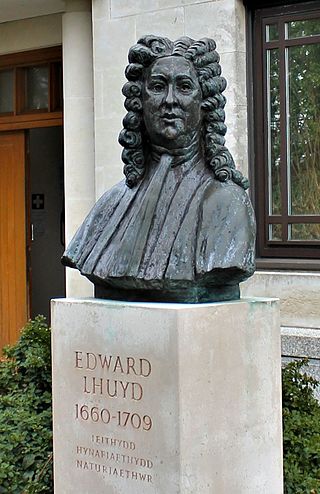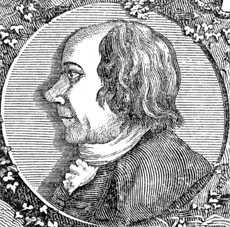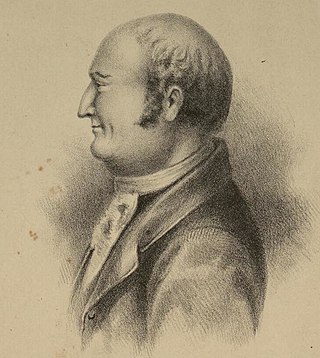Related Research Articles

Brecknockshire, also known as the County of Brecknock, Breconshire, or the County of Brecon is one of thirteen historic counties of Wales, and a former administrative county. Named after its county town of Brecon, the county is mountainous and primarily rural.

Edward Lhuyd was a Welsh naturalist, botanist, linguist, geographer and antiquary. He is also named in a Latinate form as Eduardus Luidius.

Talgarth is a market town, community and electoral ward in southern Powys, Mid Wales, about 12 miles (19 km) north of Crickhowell, 19 miles (31 km) north-east of Brecon and 15 miles (24 km) south-east of Builth Wells. Notable buildings in the town include the 14th-century parish church and a defensive tower house. According to traditional accounts, Talgarth was the capital of the early medieval kingdom of Brycheiniog. It is in the historic county of Brecknockshire. In 2011, it had a population of 1,724.

Welsh nationalism emphasises and celebrates the distinctiveness of Welsh culture and Wales as a nation or country. Welsh nationalism may also include calls for further autonomy or self determination which includes Welsh devolution, meaning increased powers for the Senedd, or full Welsh independence.

Sir Glanmor Williams was one of Wales's most eminent historians.
Gruffydd Robert (1527–98) was a Welsh Catholic priest and humanist scholar who in 1567 wrote a pioneering Welsh grammar while in exile in Italy with his uncle and fellow-writer Morys Clynnog.
This article is about the particular significance of the year 1820 to Wales and its people.
This article is about the particular significance of the year 1807 to Wales and its people.
This article is about the particular significance of the year 1801 to Wales and its people.
This article is about the particular significance of the year 1797 to Wales and its people.
The Welsh History Review is a peer-reviewed academic journal covering the history of Wales. It is published in four parts per volume, one volume every two years. The journal was established in 1960. The editors-in-chief are Huw Pryce and Paul O'Leary.

The Cambrian Archaeological Association was founded in 1846 to examine, preserve and illustrate the ancient monuments and remains of the history, language, manners, customs, arts and industries of Wales and the Welsh Marches and to educate the public in such matters. The association's activities include sponsoring lectures, field visits, and study tours; as well as publishing its journal, Archaeologia Cambrensis, and monographs. It also provides grants to support research and publications.
The Pembrokeshire Historian: journal of the Pembrokeshire Local History Society was an annual English-language local history journal published by the Pembrokeshire Historical Society. It contains academic and general articles on historical and archaeological topics. In 1985 it was renamed Cylchgrawn Cymdeithas Hanesyddol Sir Benfro /Journal of the Pembrokeshire Historical Society.
The National Library of Wales Journal is an annual academic journal containing scholarly articles on historical topics relating to the Library's collections, covering Welsh medieval and local history, literature, and the Welsh diaspora. It was first published in 1939. Its last printed issue was published in 2006, and it is now an electronic publication.
The Dictionary of Welsh Biography (DWB) is a biographical dictionary of Welsh people who have made a significant contribution to Welsh life over seventeen centuries. It was first published in 1959, and is now maintained as a free online resource.

William Jones was a Welsh antiquary, poet, scholar and radical. Jones was an ardent supporter of both the American and French Revolutions – his strong support of the Patriot and Jacobin causes earned him the nicknames "the rural Voltaire", the "Welsh Voltaire", and accusations of being, "a rank Republican and a Leveller". Despite his vocal support for foreign revolutions, however, Jones never advocated a violent Welsh republican uprising against the House of Hanover and instead encouraged the Welsh people to emigrate en masse to "The Promised Land"; in the newly founded United States of America. Like many subsequent Welsh nationalists, however, Jones also held very strong anti-English sentiments. He often expressed an intense hostility to the completely Anglicised Welsh nobility, their policies of rackrenting, and their employment of land agents whom he considered, "destitute of the principles of justice [and] moral honesty". Similarly to Saunders Lewis, Jones was equally enraged by the increasing language loss among lower class Welsh people, which led to one contemporary to describe Jones as "the hottest arsed" Welshman he had ever met.
Brecknock Society and Museum Friends is a Welsh historical society that promotes "the study and understanding of the Archaeology, History, Geology, Natural History, the Arts and Literature of Wales, especially the historic county of Brecknock."

The Welsh dance, also known as the Welsh folk dance, is a traditional dance in Wales, performed to Welsh traditional music and while usually wearing a traditional Welsh costume.

Theophilus Jones was a Welsh lawyer, known as a historian of Brecknockshire.
This article is about the particular significance of the year 1726 to Wales and its people.
References
- ↑ F. R. Rowley, Elijah Howarth, W. Ruskin Butterfield, Charles Madeley, eds. (1957). Museums Journal, p. 181. Museums Association
- ↑ Williams, Glanmor (Ed.) (1960). Welsh History Review (Cylchgrawn Hanes Cymru), p. 255
- ↑ Williams, Glanmor (Ed.) (1960). Welsh History Review (Cylchgrawn Hanes Cymru), p. 363
- ↑ Hey, David (2008). Oxford Companion to Family and Local History. Oxford [Oxfordshire]: Oxford University Press. p. 94. ISBN 0-19-953298-2.